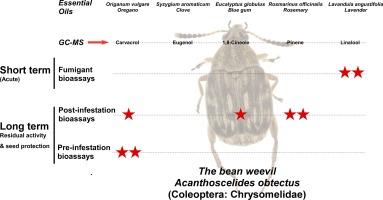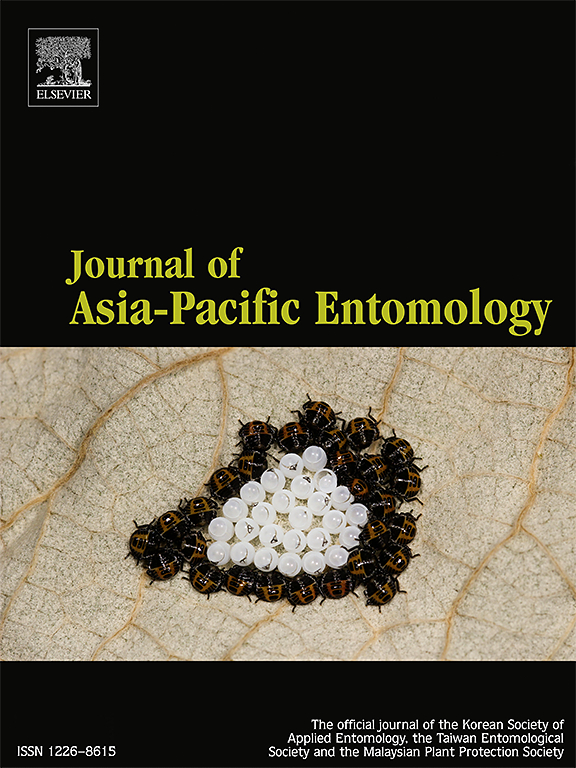Dual-mode evaluation of five essential oils for rapid knockdown and seed protection against Acanthoscelides obtectus (Coleoptera: Chrysomelidae)
IF 1.3
3区 农林科学
Q3 ENTOMOLOGY
引用次数: 0
Abstract
This study evaluated the chemical composition, fumigant toxicity, and residual efficacy of five commercial essential oils (EOs), Origanum vulgare (L.) (Lamiaceae), Syzygium aromaticum (L.) (Myrtaceae), Eucalyptus globulus Labill. (Myrtaceae), Rosmarinus officinalis (L.) (Lamiaceae), and Lavandula angustifolia Miller (Lamiaceae), against Acanthoscelides obtectus (Say, 1831) (Coleoptera: Chrysomelidae) under laboratory conditions. Gas chromatography–mass spectrometry (GC-MS) analysis identified the dominant compound in each essential oil: carvacrol in O. vulgare, eugenol in S. aromaticum, 1,8-cineole in E. globulus, α-pinene in R. officinalis, and linalool in L. angustifolia. Fumigant bioassays revealed that L. angustifolia exhibited the fastest and most potent adulticidal effect, with 100 % mortality at 1.5 µL within 24 h. In post-infestation trials, R. officinalis provided the highest suppression of adult emergence (99.05 %), followed by O. vulgare and E. globulus. Pre-infestation treatments revealed that O. vulgare completely prevented adult emergence and seed damage across all concentrations, even after 45 days. The results highlight both the acute and long-lasting protective actions of EOs, suggesting their suitability as eco-friendly alternatives for managing A. obtectus in stored beans.

五种精油快速抑菌和种子保护作用的双模式评价(鞘翅目:金曲蝇科)
本研究评估了五种商业精油(EOs)的化学成分、熏蒸毒性和残留功效。(Lamiaceae), Syzygium aromaticum (L.)(桃金娘科),蓝桉。(桃金娘科),迷迭香(Lamiaceae)和Lavandula angustifolia Miller (Lamiaceae)在实验室条件下对抗棘虫(Say, 1831)(鞘翅目:金曲蝇科)。气相色谱-质谱联用(GC-MS)分析鉴定出各挥发油的优势成分为:芫荽中的香芹醇、香樟中的丁香酚、金莲中的1,8-桉叶脑、山茱萸中的α-蒎烯和刺叶中的芳樟醇。熏蒸剂的生物测定结果表明,油叶菊的杀虫效果最快,24 h内1.5µL的杀虫率为100%,对成虫羽化的抑制效果最好,达99.05%,其次是黄叶菊和球叶菊。侵染前处理表明,即使在45天后,在所有浓度的情况下,臭草都能完全阻止成虫的羽化和种子的破坏。结果强调了EOs的急性和长期保护作用,表明它们适合作为管理储存豆子中的A. obtectus的环保替代品。
本文章由计算机程序翻译,如有差异,请以英文原文为准。
求助全文
约1分钟内获得全文
求助全文
来源期刊

Journal of Asia-pacific Entomology
Agricultural and Biological Sciences-Insect Science
CiteScore
2.70
自引率
6.70%
发文量
152
审稿时长
69 days
期刊介绍:
The journal publishes original research papers, review articles and short communications in the basic and applied area concerning insects, mites or other arthropods and nematodes of economic importance in agriculture, forestry, industry, human and animal health, and natural resource and environment management, and is the official journal of the Korean Society of Applied Entomology and the Taiwan Entomological Society.
 求助内容:
求助内容: 应助结果提醒方式:
应助结果提醒方式:


